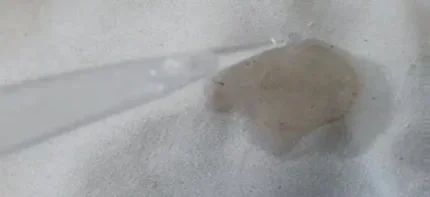
Stain removal frequently presents the cleaner with some of the most difficult to resolve issues, not least of which is the customer who is adamant that the stain was not there when the item was left for cleaning. This is a case where tact and diplomacy has to be the order of the day, but you must be certain you are not to blame as there are many items customers leave in pockets which may mark off during cleaning.
It is also the case that some absorbed water based stains such as white wine or stains containing sugar may not leave a visible mark and are not seen prior to drycleaning but when exposed to heat in drying or finishing the stain may develop and become visible. In many cases the customer will quite understandably be unaware that they had spilt something on their garment. These heat developed stains, are common and may not be easily soluble in water based spotters.
How to proceed
The vast majority of developed stains are water-based and where they have a sugary content the stain may cause some stiffening of the fabric and as stains of this nature can be expected to be water-based the edges of the stain are likely to be clearly defined.
Start by applying bar soap and 5% ammonia and flush through gently with the steam gun then use a kit blood spotter and some gentle mechanical action with the spatula or by tamping. If the stain does not respond, apply more blood spotter, closely confine the item in a plastic bag and leave in a warm place for around half an hour; this will give the enzyme in the spotter time to convert any hear set sugar in the stain back to a more soluble form. Remove the plastic bag and flush out using water and mechanical action. If any brown stain remains, bleach with 9% peroxide; also consider using rust remover as it is just possible it there may be some residual iron present but flush out well and neutralise with 5% ammonia.
For unknown stains where you haven’t a clue, if the item has been drycleaned chances are the stain will be water based, and if wetcleaned remaining stains are likely to be oil based. Try to keep an open mind and if oil based spotters aren’t working try the wetside reagents and vice versa. Always be aware that some medicines, household and garden products contain iron and rust remover may be necessary in the final stages.
General advice
Many of the major problems that arise in cleaning and stain removal could be easily avoided if cleaners introduced some sensible additional counter and production procedures. However, it goes without saying that staff must be well trained.
Here are some suggestions.
1. Consult the manager/operator when accepting high value items.
2. It is unwise to give positive assurances when discussing stains with the customer.
3. Where possible remove trims/ adornments before cleaning – alternatively test/protect
4. Do not wetclean high value items where the care label indicates dryclean only.
5. If you are unsure of the response of a high value item to cleaning don’t accept it.
6. Only use ‘owner’s risk’ after a full explanation and if you are very sure of a good outcome.
Always establish the value of high value items with the customer and do not accept them from friends or relatives.
Finally, due to Health and Safety considerations, there are unfortunately some stains, super glue being a good example, where there are now no chemical reagents I could recommend for use on the spotting table.



